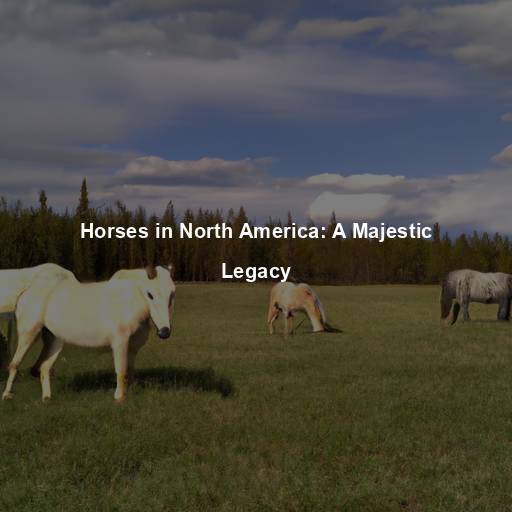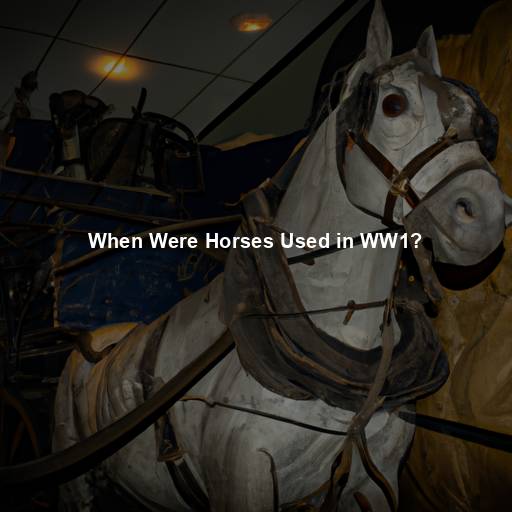Horses in North America: A Majestic Legacy
Last Updated on November 14, 2023 by Evan
Contents [hide]
- 1 The Rich History of Horses in North America
- 2 The Modern-Day Impact of Horses in North America
- 3 The Enduring Spirit of Horses
- 4 The Future of Horses in North America
- 5 A Call to Action: Cherishing the Legacy
- 6 The Importance of Horse Welfare and Responsible Ownership
- 7 The Enduring Spirit of Horses in North America
- 8 FAQs for Horses in North America
- 8.1 What is the history of horses in North America?
- 8.2 What are some common horse breeds found in North America?
- 8.3 How are horses used in North America today?
- 8.4 Are there any specific horse-related events or festivals in North America?
- 8.5 What are some important considerations for horse care in North America?
- 8.6 Are there any wild horse populations in North America?
The Rich History of Horses in North America
The history of horses in North America is a tale as old as time itself. From the vast grasslands of the Great Plains to the rugged terrains of the Rocky Mountains, these magnificent creatures have left an indelible mark on the continent. Let us embark on a journey through time to explore the fascinating story of horses in North America.
Arrival of Horses: A Transformative Encounter
The arrival of horses in North America can be traced back to the 16th century when Spanish explorers brought them to the continent. This encounter between humans and horses would forever alter the course of history. The Native American tribes, who had never seen these majestic animals before, quickly recognized their potential and formed a deep bond with them.
The Horse as a Symbol of Freedom and Power
For the Native American tribes, horses became an integral part of their culture and lifestyle. These magnificent creatures were not merely means of transportation but represented freedom, power, and a spiritual connection with nature. The horse became a symbol of the tribes’ strength and resilience, as they relied on them for hunting, warfare, and survival in the vast landscapes of North America.
The Role of Horses in the Westward Expansion
As European settlers began to explore and settle in North America, horses played a pivotal role in the westward expansion. The horse was a vital asset for pioneers and settlers, enabling them to traverse long distances and conquer the untamed wilderness. From the Oregon Trail to the California Gold Rush, horses became indispensable companions on the arduous journey towards new opportunities and a brighter future.
The Wild Mustangs: An Icon of the American West
No discussion of horses in North America would be complete without mentioning the wild mustangs. These free-roaming descendants of horses brought by the Spanish conquistadors have become an enduring symbol of the American West. With their untamed spirit and untethered grace, mustangs continue to roam the vast expanses, captivating the hearts and imaginations of all who encounter them.
The Modern-Day Impact of Horses in North America
While the historical significance of horses in North America cannot be overstated, their impact extends far beyond the annals of history. Even in the modern era, horses continue to play a vital role in various aspects of North American society.
Equestrian Sports: A Thrilling Spectacle
Across the expanse of North America, there has been an indescribable surge of fascination and adoration for equestrian sports that has left spectators spellbound. With each flick of the mane and each graceful stride, these sports weave together a tapestry of awe-inspiring horsemanship and sheer athleticism that leaves hearts pounding and breaths suspended. From the refined elegance of dressage, where riders and their equine partners dance in perfect harmony, to the heart-racing adrenaline of show jumping, where the stakes are high and the thrill palpable, and even the rugged intensity of rodeos that infuses the air with an electric energy, these sports unveil a realm where humans and horses transcend the boundaries of language and culture. Indeed, these awe-inspiring displays celebrate the profound connection that can be forged between these majestic creatures and their humanity counterparts, leaving onlookers perplexed and captivated by the sheer beauty and burst of emotions that unfold before their very eyes.
Therapeutic Benefits of Equine-Assisted Therapy
Horses possess a remarkable ability to heal not just the body but also the mind and soul. Equine-assisted therapy has emerged as a powerful form of therapy for individuals facing physical, cognitive, and emotional challenges. The gentle presence of horses, coupled with their intuitive nature, provides a safe and nurturing environment for individuals to find solace, build trust, and embark on a journey of personal growth and healing.
Conservation Efforts: Protecting Wild Horses and Their Habitat
In recent years, there has been a growing recognition of the need to protect the wild horses and their natural habitats. Various organizations and government agencies are working tirelessly to ensure the preservation of these iconic creatures and the delicate ecosystems they inhabit. Through conservation efforts and sustainable management practices, steps are being taken to maintain the delicate balance between the needs of horses and the preservation of North America’s natural heritage.
The Enduring Spirit of Horses
As we contemplate the profound heritage of horses in North America, it becomes strikingly apparent that their indomitable essence is one of their most mesmerizing qualities. Whether gracefully soaring across vast expanses of untamed wilderness or effortlessly executing elaborate routines within an enclosed arena, these elegant creatures encapsulate a unique blend of poise, fortitude, and untamed allure.
A Source of Inspiration and Wonder
Horses have captivated the human imagination for centuries, inspiring countless works of art, literature, and film. Their noble presence and innate wisdom continue to ignite our sense of wonder and awe. The bond between humans and horses transcends language and culture, reminding us of the profound connections we can forge with the animal kingdom.
A Testament to the Power of Unity
The saga of horses in North America bears witness to the extraordinary connection forged between mankind and animals, weaving together a narrative brimming with awe-inspiring collaboration and reverence for the environment. In our collective memory, it serves as a profound testament to the boundless feats attainable when humanity unites, cherishing the precious tapestry of nature that envelops us. Beyond conquest and discovery, the legacy of horses on this continent unveils a captivating tale of symbiosis, intermingling the symphony of human and equine camaraderie into an unyielding bond that defies explanation.
Throughout the vast expanse of North America, horses have faced a myriad of challenges that have stirred both concern and curiosity. From the moment they traversed the continent alongside Native American tribes, their fate became intertwined with the ever-shifting landscape. As the westward expansion unfolded, these majestic creatures found themselves embroiled in a perplexing dance of survival amidst the changing tides of progress. Today, as we stand in awe of their enduring presence in modern society, we must grapple with the intricate task of safeguarding their legacy for future generations.
While horses have made an undeniable impact on North America, they have also faced numerous challenges throughout history. Understanding these challenges is crucial to ensure the well-being and preservation of these magnificent creatures.
Habitat Loss and Fragmentation
The majestic horses of North America face a vexing threat – the relentless loss and fragmentation of their cherished habitats. As human populations surge and urban sprawl seizes the natural landscapes, the once abundant refuge for these creatures dwindles away. The shattered remnants of their domains bring forth a conundrum of isolation and scarce resources, painting a grim picture for the survival of these beloved beings.
Overgrazing and Competition for Resources
In certain parts of the world, the issue of excessive horse grazing has emerged as a major cause for worry, especially in places where resources are scarce. The overabundance of horses can result in the deterioration of rangelands and intensify the struggle for sustenance and water amongst native wildlife. Achieving a harmonious coexistence between the preservation of wild horse populations and the maintenance of a healthy ecosystem presents itself as an intricate challenge, demanding the implementation of careful and intelligent conservation methods.
Captivity and Welfare Concerns
While many horses roam freely in the wild, a significant number are also kept in captivity for various purposes, including domestication, entertainment, and sport. It is essential to ensure the welfare and ethical treatment of horses in captivity, providing them with appropriate living conditions, veterinary care, and opportunities for natural behaviors.
Disease and Health Management
Horses, just like any other living beings, are not immune to the complexities that come with health challenges. These majestic creatures, both free and domesticated, can fall victim to contagious illnesses that spread like wildfire, casting a dark shadow on their overall well-being. Upholding the vitality of horses across North America necessitates implementing a comprehensive approach to disease management, encompassing essential vaccinations and stringent biosecurity measures. By doing so, we strive to protect these remarkable animals from the adversity that lurks in their midst.
The Future of Horses in North America
In a world where the fate of magnificent horses hangs in the balance, we find ourselves entangled in a web of intricate challenges. Exploring the perplexing terrain of horse conservation and management in North America, we uncover the need for a collective approach. It is within the collaboration of government agencies, conservation organizations, scientists, and local communities that the keys to guaranteeing the enduring vitality and welfare of these remarkable creatures lie.
Sustainable Population Management
Ensuring a harmonious coexistence between wild horses and their fragile ecosystems is of paramount importance. By adopting prudent and scientifically-backed approaches to population management, like the integration of fertility control programs, we can navigate the intricate web of preserving these majestic creatures and safeguarding their habitats. Such conscientious measure will help strike a delicate equilibrium between the needs of wild horses and the finite resources bestowed upon their environment, paving the way for a sustainable future.
Education and Awareness
Raising public awareness about the importance of horses in North America and the challenges they face is vital. By educating communities, policymakers, and the general public about the ecological, cultural, and historical significance of horses, we can foster a deeper appreciation and understanding of their role in our shared heritage.
Continued Research and Monitoring
The dynamic world of horses in North America has captivated the attention of researchers who are tirelessly delving into their behavior, ecology, and health. The continuous efforts in monitoring and research are like hidden keys, unlocking precious data and insights about these majestic beings. Through studying their populations, unraveling migration patterns, and exploring their genetic diversity, scientists are reinforcing the foundation for conservation strategies to secure the future of these remarkable creatures.
Collaboration and Partnerships
Preserving the timeless essence of North America’s majestic horses beckons for an intricate dance of collaboration and partnership amongst a tapestry of stakeholders. As the government agencies, conservation organizations, indigenous communities, and local landowners harmonize their passions and synergize their wisdom, the collective force propels towards a shared, illustrious mission: safeguarding and cherishing these extraordinary creatures. Together, these advocates intertwine their expertise and pool their resources, crafting a tapestry of protection and preservation, encapsulating the enigmatic allure of these cherished equine beauties.
A Call to Action: Cherishing the Legacy
In conclusion, horses in North America have left an indelible mark on the continent’s history, culture, and landscape. From their historical significance to their continued presence in various aspects of modern society, horses embody the enduring spirit of unity, companionship, and harmony between humans and animals.
As stewards of this extraordinary heritage, we bear the weighty duty of protecting, preserving, and responsibly overseeing the equine population in North America. By immersing ourselves in conservation endeavors, raising public consciousness, and embarking on joint endeavors, we can shield the destiny of these awe-inspiring beings and pay homage to the deep connection they forge with us. Let us embrace the challenge of nurturing their well-being amid an ever-changing world, ensuring their legacy endures with resplendent grace.
Join us as we delve into the captivating world of horses in North American culture. From their awe-inspiring presence to their role in shaping our history, these magnificent creatures have left an indelible mark on our hearts and minds. Together, let’s celebrate their legacy and work towards a future where horses can roam freely, reminding us of the boundless beauty and power of the natural world.
Beyond their historical and ecological significance, horses hold a special place in the hearts and culture of North Americans. They have become woven into the fabric of the continent, influencing various aspects of society.
Equine Therapy: Healing through Connection
Equine-assisted therapy has gained recognition as a powerful tool for healing and personal growth. The intuitive and non-judgmental nature of horses creates a safe space for individuals facing physical, emotional, or cognitive challenges. Through interactions with horses, individuals can develop confidence, communication skills, and emotional resilience, fostering personal transformation and well-being.
Equine-Assisted Activities and Sports
The majestic presence of horses can ignite a spark of joy and adventure in the hearts of many. Through equine-assisted activities and sports, these noble creatures have the power to touch the lives of countless individuals. From therapeutic riding programs that grant people with disabilities the exhilarating opportunity to ride on horseback, to the high-velocity realms of polo, barrel racing, and endurance riding, these activities serve as a testament to the unbreakable connection between humans and horses. They not only promote physical fitness and skill development but also foster a sense of camaraderie among enthusiasts, creating a tapestry of experiences bursting with excitement and mystery.
Equine Industry and Economic Impact
The enchanting world of horses holds a captivating sway over North America’s economy, weaving a tapestry of prosperity that stretches far and wide. With an intricate web of horse breeding, training, and sales, as well as the rhythmic gallops of equestrian events, flourishing riding schools, and a myriad of equine-related enterprises, this industry stands as a testament to the boundless potential of our majestic equine companions. Within the rolling landscapes of rural communities, horses have become not only a means of sustenance but also a catalyst for economic stability, breathing life into the dreams and ambitions of countless individuals in their quest for rural prosperity.
Art, Literature, and Entertainment
Throughout history, horses have served as an enduring muse, igniting artistic expression in various forms. Artists, writers, and filmmakers have drawn upon their mesmerizing grace, raw power, and untamed beauty to create works that resonate with audiences worldwide. From the timeless literary characters of Black Beauty and Seabiscuit to the cinematic wonders of “The Black Stallion” and “War Horse,” these majestic creatures continue to bewitch, enchant, and perplex us, leaving an indelible mark on our collective imagination. Their allure is as burstingly captivating as ever, reminding us of the eternal bond between mankind and these awe-inspiring beings.
The Importance of Horse Welfare and Responsible Ownership
From the sheer joy they bring to the warmth of their companionship, horses have a way of touching our hearts and inspiring us like no other. But amidst the undeniable allure, we mustn’t forget our duty to prioritize their wellbeing and foster a culture of responsible ownership. Whether they roam free or grace our stables, horses are noble beings who deserve to be showered with dignity, unwavering respect, and boundless compassion.
Proper Care and Nutrition
Ensuring the optimal welfare of our four-legged companions is an absolute imperative. A holistic approach encompassing hydration, nourishment, veterinary attention, and safe haven, reigns supreme in the conscientious horse owner’s handbook. True stewards of equine health grasp the significance of vigilantly overseeing their noble steeds’ vitality, upholding the strength of their hooves, and diligently tending to any medical matters without delay.
Training and Handling
Gentle and ethical training methods are crucial for the physical and mental well-being of horses. Positive reinforcement, patience, and clear communication help build trust and create a harmonious partnership between horse and rider. It is important to avoid harsh or abusive training techniques that can cause physical and psychological harm to these sensitive animals.
Sustainable Horsekeeping Practices
When it comes to taking care of our equine companions, being responsible extends beyond just feeding and grooming. It’s about embracing sustainable horsekeeping practices that leave a positive impact on our environment. This involves smart manure management strategies, implementing thoughtful pasture rotation plans, and opting for eco-friendly materials for stabling and fencing. By making these conscious choices, we not only ensure the well-being of our horses but also contribute to the preservation of precious natural resources and the overall health of our ecosystems.
Equine Rescue and Rehabilitation
In an ever-changing world, it is fascinating to witness the vital role that equine rescue organizations play. From providing essential care and rehabilitation to offering rehoming opportunities for these majestic creatures, these organizations are truly making a difference. By supporting them through generous donations, volunteering your time, or even considering adopting a horse in need, we can collectively ensure a brighter future for these resilient beings who have endured neglect, abuse, or abandonment. Join us on this incredible journey and witness the transformative power of compassion and dedication in action.
The Enduring Spirit of Horses in North America
As we delve into the rich tapestry of North America’s equestrian heritage, we are confronted with a captivating enigma. The gentle power exuded by these majestic creatures has left an indelible mark on our collective consciousness, perpetuating a mystique that defies definition and transcends time. Their ethereal allure, seamlessly intertwined with their raw strength and undeniable elegance, serves as an eternal muse, forever stirring the depths of our souls. Although the exact trajectory of their future in our ever-evolving world remains elusive, one thing is certain—their enduring legacy will forever enchant and bewilder us.
From the wild mustangs roaming free to the gentle therapy horses providing solace and healing, horses exemplify the incredible bond between humans and animals. They remind us of the inherent connection we share with the natural world and the responsibility we have to protect and cherish these remarkable creatures.
As stewards of their legacy, let us continue to advocate for the welfare and preservation of horses in North America. Through education, responsible ownership, conservation efforts, and a deep appreciation for their cultural and ecological significance, we can ensure that horses continue to gallop through the pages of North American history, leaving an indelible hoofprint on our hearts.
FAQs for Horses in North America
What is the history of horses in North America?
Horses were actually extinct in North America for thousands of years until they were reintroduced by Spanish explorers in the 16th century. These explorers, including Hernán Cortés and Francisco Vázquez de Coronado, brought horses back to the continent during their expeditions. Eventually, the horse population spread and multiplied, leading to the establishment of wild herds across North America.
What are some common horse breeds found in North America?
In the vast expanse of North America, a captivating kaleidoscope of equine diversity unfurls. Behold the American Quarter Horse, a majestic marvel boasting boundless speed and remarkable adaptability. Allow your gaze to linger upon the Appaloosa, a mesmerizing masterpiece adorned with enchanting patterns adorning its noble coat. And among these equestrian treasures, we encounter the Tennessee Walking Horse, gracefully gliding with a gentle disposition that warms the soul. But let us not overlook the radiant Paint Horse, the regal Arabian Horse, and the venerable Morgan Horse, all lending their unique allure to this remarkable tapestry of equine excellence.
How are horses used in North America today?
In the vast expanse of North America, horses emerge as enigmatic beings of countless roles and remarkable versatility. Steadfast companions in recreational pursuits, they grant humans the freedom to traverse uncharted terrains on their backs, be it for a leisurely ride through nature’s tapestry or the exhilaration of driving towards uncharted horizons. These magnificent creatures further enliven the spirited arenas of competitive sports, showcasing their grace and agility in riveting displays of horse races, daring jumps, refined dressage routines, and adrenaline-soaked rodeo spectacles like the electrifying barrel racing and the art of roping. Yet, perhaps one of the most fascinating aspects is that horses, amidst the modernity of our times, continue to be indispensable allies to ranchers and farmers, diligently lending their strength and swift hooves in the timeless tasks of herding livestock, providing indispensable transportation, and gracefully treading through the great outdoors in harmonious synergy with their human counterparts.
From the thunderous gallop of hooves to the fluttering excitement in the crowd, horse-related events and festivals paint a vibrant picture across North America. Among these illustrious spectacles, the Kentucky Derby reigns supreme as the pinnacle of equine grace and agility, captivating audiences annually in Louisville, Kentucky. Venturing north, the Calgary Stampede in Alberta, Canada, sets the stage for a thrilling rodeo extravaganza, spotlighting a symphony of equestrian prowess. Juxtaposed with these grand displays, state fairs and county fairs throughout the continent offer a more intimate glimpse into the world of horses, where their majestic beauty and untamed spirits are celebrated and appraised.
What are some important considerations for horse care in North America?
Keeping horses healthy and happy is of utmost importance in North America. From providing them with nourishing sustenance and pristine living conditions to ensuring regular veterinary check-ups and administering crucial vaccinations and deworming treatments, the welfare of these graceful creatures demands our undivided attention. Moreover, maintaining their physical and mental well-being is key, emphasizing daily exercise and mental stimulation. Handling horses with care, using appropriate training techniques and equipment, is essential for their overall health and emotional fulfillment. Every stride we take to ensure proper horse care is a testament to our dedication to these majestic beings.
Are there any wild horse populations in North America?
Yes, there are wild horse populations in North America, particularly in areas such as the western United States and parts of Canada. The most famous and iconic of these wild horses are the mustangs, which are descendants of the horses brought over by the Spanish explorers centuries ago. These wild horses live in designated areas managed by government agencies and are protected by law. However, managing wild horse populations can be a complex issue due to the competing needs of grazing lands and the horses’ ecological impact.







